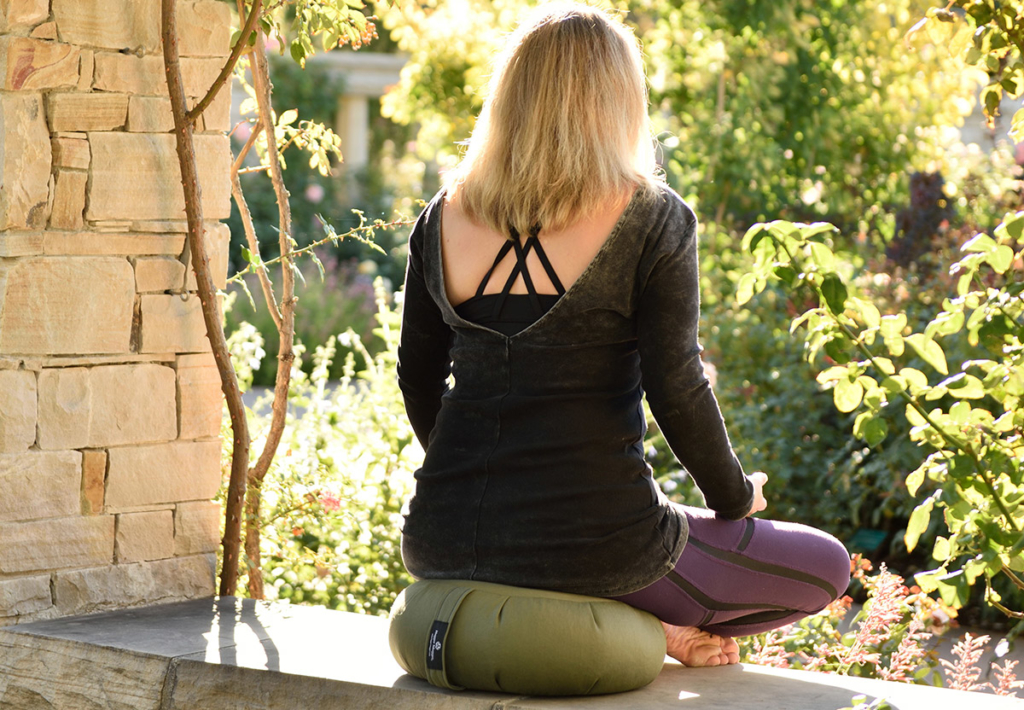
I have the good fortune to teach a mindfulness class each summer at Salt Lake City’s Red Butte Garden. The area where we practice is situated next to a pond with a small waterfall. We often practice hearing meditation to the tune of running water, birdsong and the sound of a gentle breeze. It’s a very peaceful place to practice—most of the time. Sometimes, though, the aural environment is dominated by weed whackers and backup beepers. This could make it challenging to find peace in our practice. But instead of feeling frustrated by the intrusion of these less pleasant sounds, we invite them in. They’re what’s happening in the present moment, after all.
Having a beautiful, quiet, capacious space for yoga and meditation practice is a gift. Meditation retreat centers and yoga studios strive to create a calming environment for practice. But even so, some factors are out of our control. Weather, construction, background noise—you name it—can make it difficult to find peace.
Yoga sutra 1.2 defines yoga, and by definition meditation, as “the settling of the mind into silence.” This sutra is often interpreted as a state where our minds cease to think. The “monkey mind” takes a nap. But the silence to which this sutra refers is much more expansive than that. The silence of yoga is not dependent on outer, or even inner, conditions. Yoga’s silence is like the sky—unaffected by wind, clouds, rain, snow or even violent storms. No matter what, the sky remains clear and expansive. Awareness can be that.
How to Find Peace in the Midst of Chaos
How can we find peace even when our environment is chaotic and our thoughts are spinning? This question points at the true value of our practice to enhance our daily lives. Our lives will always present challenges. As with my classes at the arboretum, some days we get birdsong, cool breezes and a waterfall. Other days we get the weed whacker. And it’s not up to us.
Mindfulness practice has a solution. I’m happy to say that my Red Butte mindfulness students have found this to be profoundly helpful. Instead of resisting the weed whacker when it’s present, we instead let it be part of our meditation. After all, it’s what is actually happening in the present moment. Resisting it, or getting angry or frustrated is a choice. That choice has particular consequences for our ability to find peace. We also have a choice to let the sound simply be, for however long it stays around. The consequences of this choice are entirely different.
Sound is vibration, after all. So we hear it not just with our ears, but we tune into where it resonates in our bodies. By investigating it as an object of meditation, we remove the frustration or annoyance that makes us suffer. We can find peace in that sky-like awareness in the midst of it.
The same is true for all manner of discomforts—heat or cold, mild bodily discomforts, smells, tastes and sights. We should, of course, discern whether a particular discomfort could cause injury before we decide to simply sit with them. But most minor annoyances are ripe for investigation.
Taming the Wild Monkey
In the same way, we can be aware of the monkey mind. For perspective, here are a few facts about thinking. In 2005, the National Science Foundation published an article claiming that humans have 12,000 to 60,000 thoughts ever day. Ninety-five percent of those thoughts are the same ones we had yesterday. So if there’s lots of thinking happening when you sit down to meditate, you’re not doing something wrong. You’re simply being human. And we can all agree that, on balance, the ability to think is a positive in our daily lives.
But thoughts are not all the same. Some are helpful and onward leading; others, not so much. That 95 percent of thoughts that we’re running over and over are likely the latter. When thinking is rampant, we can settle back in awareness and simply notice that thinking is what’s present. When we step back from our thoughts and simply observe them, it’s easier to see which ones we might want to pursue, and which ones we might want to let go.
Remember that it’s not whether thoughts, sounds or other challenging sensations are present that determines whether we find peace. What’s important is how we respond to them. Can we allow them to be present, even as we rest in a state of curious awareness?
